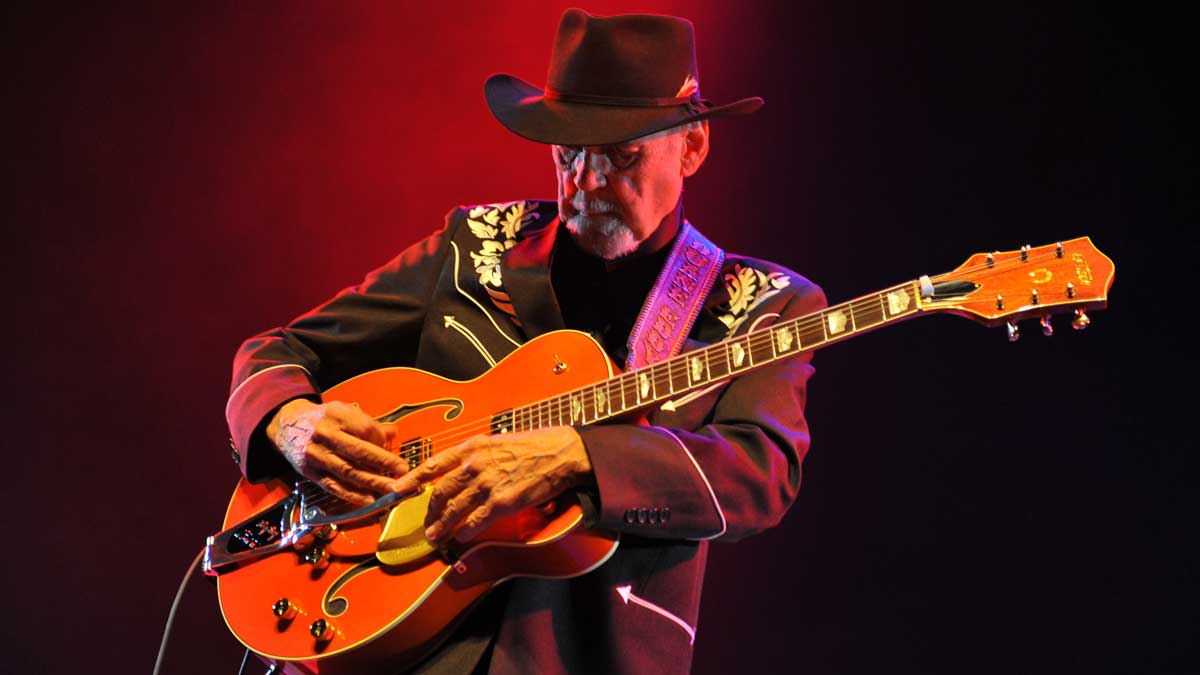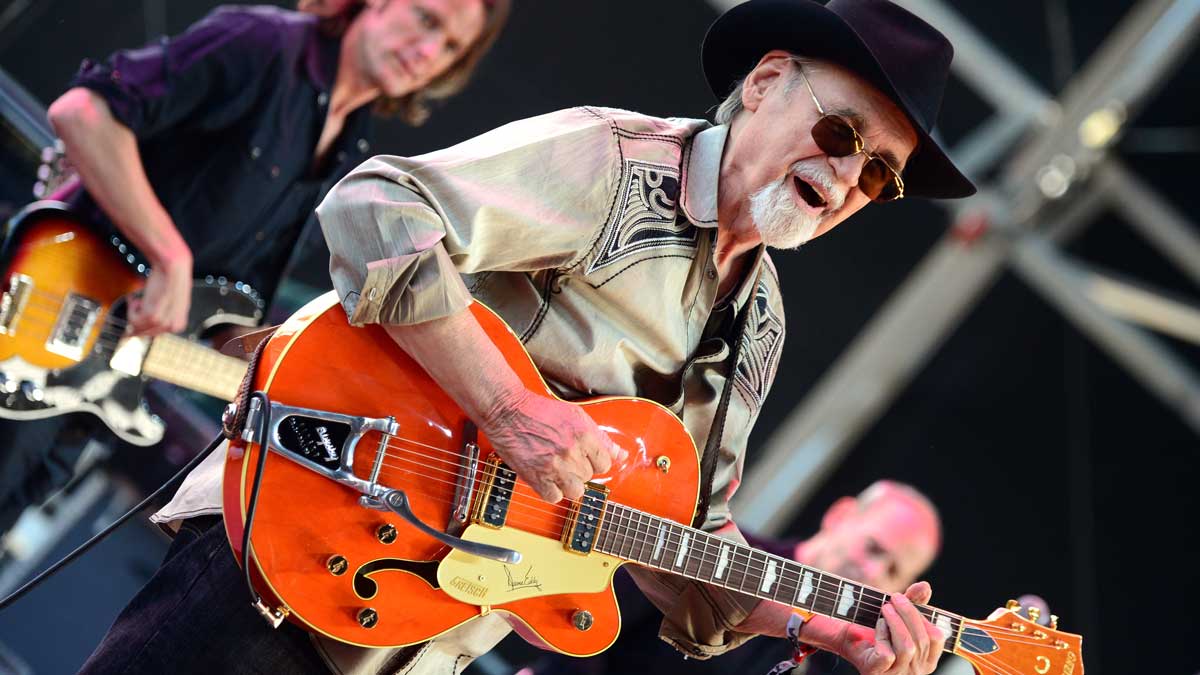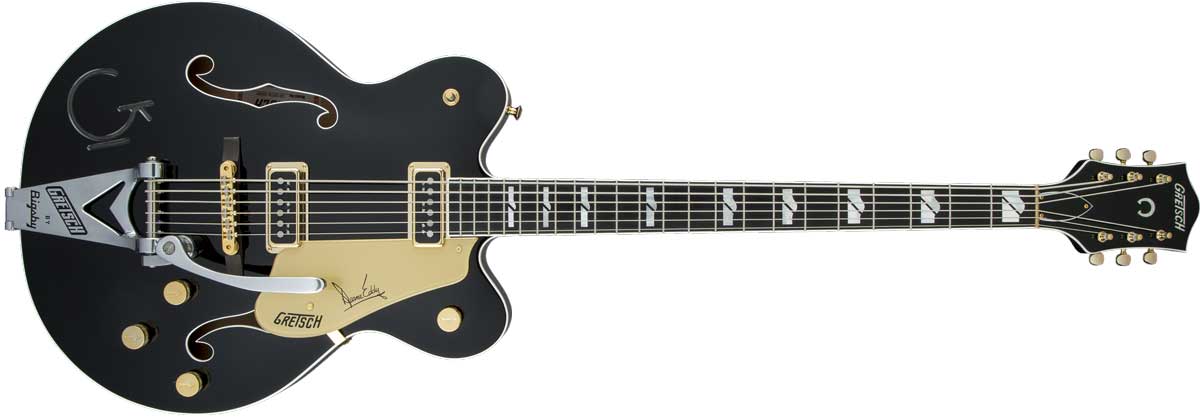Duane Eddy: “You use the technology and don’t let it use you. I can’t get that through to people”
The titan of twang on tone, tales and the story behind his signature Gretsch six-string bass guitar

People celebrate selling thousands of singles or albums these days. Duane Eddy has sold 100 million. Ultimately, the numbers don’t matter, but they do serve to show the scale of the pervasive influence of an iconic guitarist.
Eddy is one of that cross-generational handful of players who’s sound is truly unmistakable. The twanging tone established on the likes of Cannonball, Moovin’ And Groovin’ and Rebel Rouser made him an icon, beloved by The Beatles and Elvis, as much as modern heroes like Dan Auerbach and Richard Hawley, both of whom have collaborated with Eddy.
Now he’s back, at the tender age of 80, celebrating this big birthday with a new signature Gretsch six-string bass and a run of UK shows. We spoke to Eddy about his thoughts on tone, his ideal amp and the story behind his beautiful new six-string Gretsch bass.
Who were your first loves when it came to guitar players?
I like to do my basic tracks on tape and then you can dump it into digital and it doesn’t lose anything
“I listened to mostly country music when I was growing up. I learned to play by playing along to country records on the radio and was exposed to Merle Travis and Chet Atkins when I was 14 or so. Before that there were people like Billy Byrd, who was a great jazz player, but he played with [country singer] Ernest Tubb.
“Who else? Grady Martin who was just a couple of years older than me, but he was a session player in Nashville from when he was very young. He did things like El Paso [1959] with Marty Robbins and he came up with the first fuzz tone on Don’t Worry with Marty Robbins in 1960 [actually 1961].”
Speaking of tones, you’ve been into interesting sounds and studio experimentation since your earliest recordings. Where do you stand on the digital versus analogue debate? Are you an analogue purist?
Get the MusicRadar Newsletter
Want all the hottest music and gear news, reviews, deals, features and more, direct to your inbox? Sign up here.
“No, no, no. I was for a while because digital just, in a word, sucked! [laughs] I tried to record and it was just a big jangle, so I went back to 24-track analogue and said, ‘That’s the only way I’m goin’.’’ I still like to, like Dan [Auerbach] does, have that tape running. I like to do my basic tracks on tape and then you can dump it into digital and it doesn’t lose anything. It stays there. And it has the warmth and the power and the feeling that analogue gives you, but you can add to that because the digital is clear as a bell and pristine. That’s the way I like to work today and that’s the way Dan works - part-analogue.
“I hear that Mark Knopfler does that. He’s got 16 tracks hooked up in his studio and he’ll record analogue then dump it into digital and mix it so he has the advantage of both. That’s the idea: you use the technology and don’t let it use you. I can’t get that through to people.”

You mentioned Dan Auerbach there. He told us that when you arrived to work with him on Waiting For A Song, you had your Gretsch guitars, your amp and a tremolo pedal and that was your sound - just like that…
“I just figure that that’s my sound, my voice. I bring my amp, which has a 15” JBL speaker in it. I had a 130-watt Music Man that I used with Dan that these guys from Texas gave me.
“Doyle Dykes, a guitar player friend of mine, was down there at this huge amp shop and he was talking about me and saying, ‘Ah, Duane’s looking for a Music Man, 130-watts with a JBL 15” D130 speaker.’ They said, ‘We just happen to have one of those. It’s in great shape. Go ahead. Take it up to him!’ He said, ‘How much do I owe you?’ And they said, ‘If it’s for Duane, you don’t owe us a thing - and he doesn’t either. We want him to have it.’ I mean, is that sweet, or what?”
That’s the second time something like that has happened. Didn’t they let you walk out the store without paying up front for your first Gretsch 6120?
“That’s right! Ziggy [of Ziggy’s Music Store in Arizona] did. He let me take it to work with me that night.”
Do you think there’s something about your personality? Are you perceived as a trust-worthy type?
“Yeah, people feel sorry for me! ‘Here you go, the poor guy, he doesn’t have a decent guitar! Take this one! He’s after this amp and he can’t find it - let him have it!’ [laughs] Nah, these guys were just sweet guys. And it does record and sound great. So that’s what I used on Dan’s stuff. I turned up with my amp and my tremolo and my two guitars, including the new six-string bass and my regular Gretsch. I just use whichever one was appropriate for the track and did the recording.”
You mentioned the new six-string bass there - the G6120TB-DE Limited Edition Duane Eddy Signature. How did you first come to play a six-string bass?
“Well, I walked into a store in 1959 in Hollywood and I saw in the window a Danelectro six-string bass. I thought, ‘Well that’s interesting.’ It was an octave lower than a regular guitar, but the same tuning. Tuned to E. It was only about $150, so a cheap guitar, but it had a great sound with those lipstick tube pickups, so I bought it. I fell in love with it. I thought, ‘Well this was made for me!’
“I never talked to Nate Daniels, the guy who came up with Danelectro, to know if he was a fan or if he just accidentally came up with it, or if he did it thinking of me. I did realise that Nate is short for Nathaniel, so his name was Nathaniel Daniels!
The six string Danelectro bass was hard to play. You couldn’t play chords on it very easily and you couldn’t bend the strings very easily
“I used it on the third album I did [The Twang’s The Thang] a lot, on all but two tracks, and I used it on [1960 hit single] Because They’re Young. Well, it was hard to play. You couldn’t play chords on it very easily and you couldn’t bend the strings very easily. It didn’t have the vibrato either and I didn’t dare [modify it]. It was compressed wood or something, so I didn’t think it was strong enough to hold one.
“They did make me one a couple of decades ago with a modern, lightweight vibrato, like a Floyd Rose, so I could divebomb on the Dano! I loved it, but I lost it in the flood of 2010 because I had it in storage. We were travelling and I didn’t want it to leave it at the house to get stolen, so it got flooded and ruined instead. Cruel fate!”

How did the option of a Gretsch signature bass come about?
“Well I finally asked Gretsch, I asked Stephen Stern, who’s the Master Builder out in California for Fender and Gretsch. I said, ‘Stephen, can you make me a six-string bass?’ I picked out a bass hollowbody from Gretsch’s bass range with a double-cut. I said, ‘Can you put a long neck on it? You know, like a Dano?’ He said, ‘What’s a Dano!?’ and I thought, ‘This is going to be a trainwreck!’ But genius that he is, I sent him the measurements of the neck on the Dano and that’s all I could send him, so he put my electronics off the 6120 and then I asked him later, ‘Did you use that bass body?’ He said, ‘Well, I looked at it, but I built my own. It’s more fun that way!’ [laughs]
“A few weeks later, it came in the mail. I opened the case and there was my brand new six-string bass and it was gorgeous. I told him I wanted it black with white binding and a subtle dark grey ‘G’ brand on it, because I’ve never had a Gretsch with a G brand. Eddie Cochran’s did, but mine didn’t. His was a ’55 or ’56 and mine was a ’57 and they stopped in ’57, so I never had one. I opened the case and looked at it and it was perfect. I picked it up and looked at it and it was a dream. He knows what kind of neck I like because he made my 6120 signature model. It was just perfect.
“[A friend of mine] Harold Bradley, here in town, is the guy that did all of that ’tic-tac’ guitar [a method of bass muting] like on Crazy with Patsy Cline… on a Dano. I showed Harold the Gretsch and he picked it up and played it and he says, ‘Well I’ll be damned… I fought that damn Dano for 50 years!’ I said, ‘Harold, you won’t believe this, but I said the exact same sentence!’”
Duane Eddy plays Manchester Bridgewater Hall on 30 October, with special guests Albert Lee and Robert Vincent. Tickets are available now.
Matt is a freelance journalist who has spent the last decade interviewing musicians for the likes of Total Guitar, Guitarist, Guitar World, MusicRadar, NME.com, DJ Mag and Electronic Sound. In 2020, he launched CreativeMoney.co.uk, which aims to share the ideas that make creative lifestyles more sustainable. He plays guitar, but should not be allowed near your delay pedals.
“Its mission is simple: unleash the power of any amplifier or line-level source without compromise”: Two Notes promises a “watershed” in tube amp control with the Torpedo Reload II
MusicRadar deals of the week: Enjoy a mind-blowing $600 off a full-fat Gibson Les Paul, £500 off Kirk Hammett's Epiphone Greeny, and so much more










